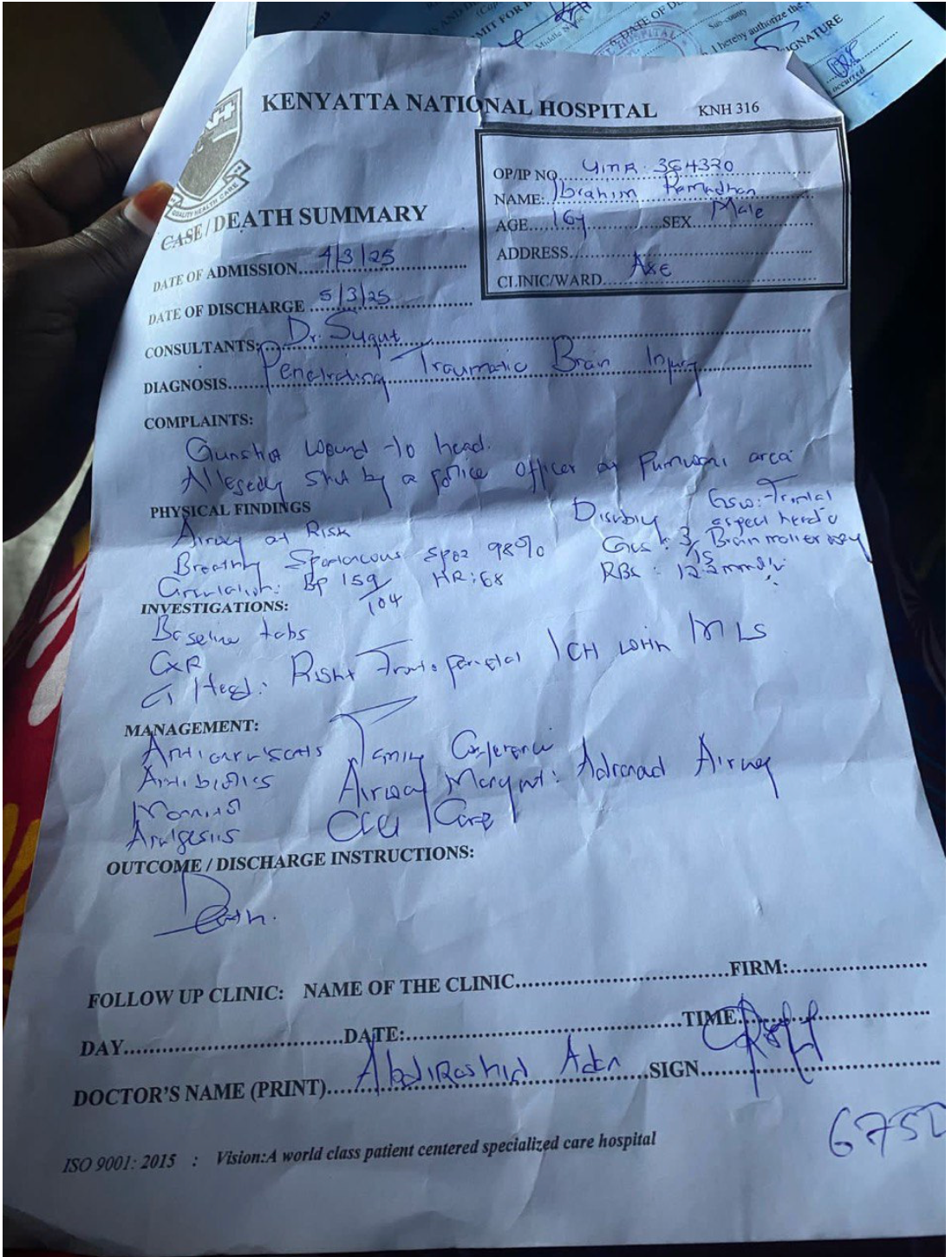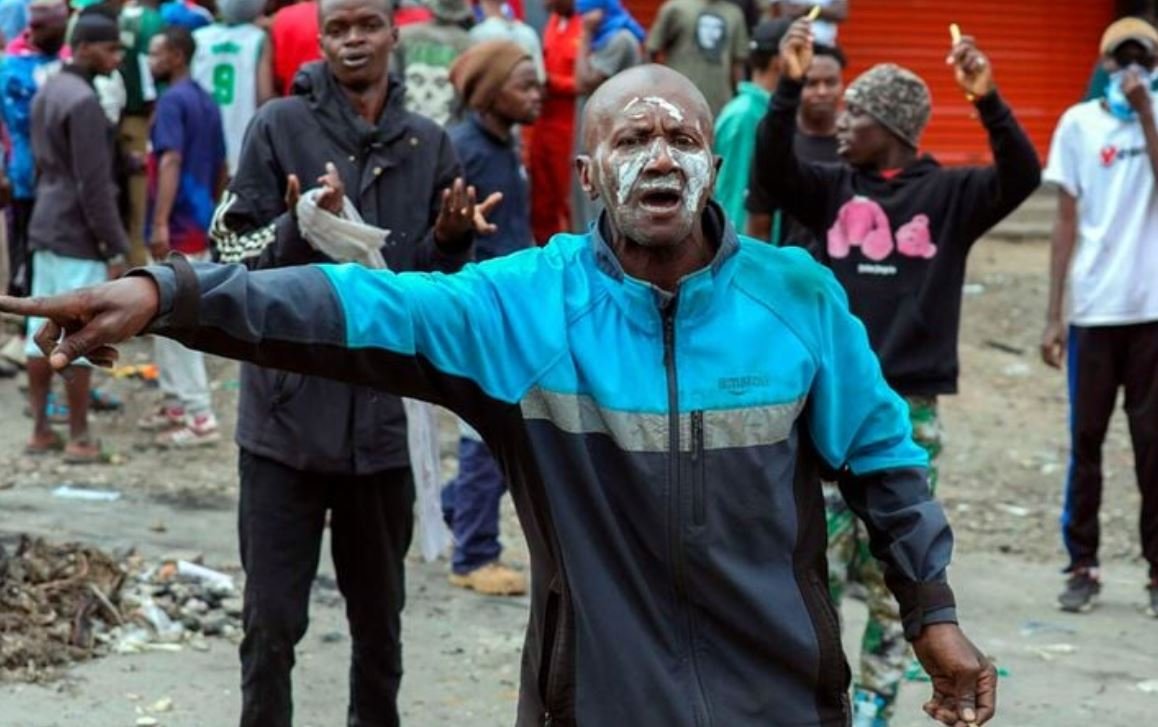The religious nature of Ibrahim Ramadan’s murder is confirmed by the fact that the victim’s brother was later arrested and beaten for his faith.
by A. Sahara Alexander

A young underage man was shot dead by a policeman just a few steps outside the gate of a mosque in a shantytown of Nairobi, Kenya. It happened in cold blood, in broad daylight, and in front of several witnesses. The minor had done nothing—except converting to the Ahmadi Religion of Peace and Light (AROPL), a religion regarded as heretical by other mainstream Muslims. The policeman who murdered the teenager was a Sunni Muslim who believed that AROPL was a heresy to be eradicated. Yet the witness who denounced this brutal homicide was also a Sunni Muslim, and a friend of the innocent victim.
Once again, religious liberty is being violently attacked by those who distort their own faith to the point of believing they have a duty to suppress all others. They are encouraged by those who kill the victims twice: pitchmen who falsify a murder motivated by religious hatred into a mere incident of ordinary crime and ideologues who brand minority religions as “cults,” weaponizing that derogatory term also to the point of inciting the weak-minded to commit slaughters.
The young man killed in Nairobi was Ibrahim Ramadhan, 17 years old. Local media in Kenya hastened to dismiss the case as yet another example of police brutality or as an anti-drug operation, completely ignoring the essential religious nature of the crime, which makes it a blatant and bloody violation of religious liberty. But “Bitter Winter” has interviewed Ibrahim’s elder brother, Salhina Said Athumani Kamau, to bring to light the truth about this absurd case, which, if misrepresented, risks being completely forgotten.
What exactly happened to your brother?
The story begins on March 1, 2025. My brother Ibrahim had recently embraced the Ahmadi Religion of Peace and Light (AROPL). On that day, he pronounced the pledge of allegiance—a believer’s commitment to Imam Abdullah Hashem Aba al-Sadiq, the leader of AROPL, who, for us, his followers, is the promised Mahdi, and ultimately to Allah. He took this oath by telling his friends he had joined AROPL and by openly sharing his beliefs within his community.
This is Majengo, a sub-location (equivalent to a neighborhood) in the Pumwani division of Kamukunji sub-county in Nairobi, the capital of Kenya. It is a predominantly Sunni Muslim area. There, Ibrahim organized meetings to read and study literature related to AROPL, usually attended by 10–15 people. It’s important to understand that Ibrahim was still very new to AROPL and not deeply knowledgeable about it, so those meetings were also learning opportunities for him.
When word of these meetings started spreading, the Chief Imam of Pumwani Riyatha Mosque, Sheikh Idrisi Nyaboga, along with other Sunni leaders, publicly condemned AROPL as a misleading teaching and a contradiction to Islam.
On the fourth day after publicly announcing his adherence to AROPL, March 4, around 8:30 PM, my brother Ibrahim left Pumwani Riyatha Mosque. In this local mosque, he prayed as a Muslim, a mosque for him, his friends, and the community. Just a few meters from the gate, a police officer stopped him. Without asking any questions, that officer shot the adolescent in the head at close range. Ibrahim was 17, a minor according to Kenyan law, and a student in the Kamukunji secondary school.
Did young Ibrahim die in front of that mosque?
No, he was severely injured by a shot to the head, but was still alive. He was rushed to Kenyatta National Hospital, and there he succumbed around 3:00 am on March 2.

Let us underline a detail, so as not to miss the point, especially for readers who may not know. The mosque in front of which Ibrahim was shot was not an AROPL mosque.
Pumwani Riyatha Mosque is the Muslim mosque in the area. It is not an AROPL mosque. Every Muslim goes there to pray, and Ibrahim, who had converted to AROPL, went there to pray alongside his friends, Sunni Muslims. For several reasons, there are no AROPL places of worship in Kenya.
So, Ibrahim came out of that mosque and was shot. Out of the blue…
His murder was a well-coordinated killing. The policeman just opened fire—without any provocation, without warning, without calling out to him…
Nothing happening there? No demonstrations, no genuine unease or agitation… maybe just some tension, or even discontent, to give a sense of instability, disturbance, or even unrest?
Yes, that is correct.
What about the other people coming out of the mosque around him? Were they threatened or targeted by the police?
When Ibrahim was outside the mosque, the police officers appeared out of nowhere. One of them came straight at him and, without saying a word, opened fire, aiming at him.
With no apparent reason for the police to be in that spot…
No… it was just a typical day, no incidents, people just doing business…
Were you there? Did you see the killing with your eyes?
No, I wasn’t there. I was called immediately by someone giving a direct account of the shooting. That person, who wishes to remain anonymous for security reasons, was my brother’s friend. Within about five minutes, I was at the scene of the murder. I saw my brother injured and rushed him to the hospital. The police officer who had shot him had already fled.
Was that eyewitness a member of AROPL?
No, the eyewitness is a Sunni Muslim.
And a friend of young Ibrahim.
Yes.
Did the police interrogate the eyewitness about Ibrahim’s murder?
No, neither that person nor anyone else at the scene that day.
You mentioned that the Chief Imam of the local mosque publicly condemned AROPL before the killing. Do you mean he spread hate speech?
Yes. Sheikhs and imams tied to the Pumwani Riyatha Mosque deeply discussed AROPL and its recent arrival in Majengo. They reiterated that AROPL’s beliefs are not Muslim and are incompatible with the Islamic faith. They concluded that AROPL threatened the community and decided that something had to be done to stop its spread. They decided to intervene… They had to take someone, you know, out so that this thing ends there, that it doesn’t spread…
But let me add that it all started even earlier, when the first rumors of AROPL arriving in the area were heard. It was at the end of the previous month, February. Then it came on February 28, a Friday, the day Sunni Muslims observe the Jumu’ah, the mandatory congregational prayer in a mosque. During the following khutbah, or sermon, the Chief Imam said it was forbidden to engage in the activities of AROPL. He warned that anyone found proselytizing for that faith, which they consider a “cult,” would be dealt with in some way.
Do you know the name of Ibrahim’s killer?
He has been identified as Mohammed Mukhtar, a Sunni Muslim from Shauri Moyo Police Station, located in the Starehe sub-county of Nairobi County.
How can you say he is a Sunni Muslim?
We, Ibrahim’s family, did research and found out. Before the assassination, he had meetings with the leaders of Pumwani Riyatha Mosque.
What happened after the assassination of young Ibrahim?
On March 5, people took to the streets to protest police brutality. Protests erupted in several Nairobi sub-locations, such as Majengo, Shauri Moyo, California, and Eastleigh. Officers violently dispersed the crowds, using tear gas and even live bullets. Eight people were shot and taken to Kenyatta National Hospital. I personally went there to check on their condition.

And Mohammed Mukhtar, the police officer who killed your brother in cold blood?
No action has been taken against him. He is free and still on duty, doing his work as if nothing had happened. He performs his duties daily as a policeman.
The official investigation into the case never reached a real conclusion. Every time we, the family, ask the investigative authorities, we get no answers. We are just told to wait, over and over. In other criminal cases in Kenya, we always see actions being taken with some results—but not in the case of young Ibrahim. It seems like nothing is being done so far.
Hate speech before the murder by Sunni Muslim clerics who had fanaticized their faith and preached against AROPL, followed by a Sunni Muslim policeman who assassinated a young AROPL believer: a private entity and the state seem to share similar interests. Is this evidence of complicity in the crime?
Complicity shows that something bigger is going on there. The killer could have been stopped, but he isn’t… The whole thing is bigger than us…
Some say your brother was shot during an anti-drug police operation, without ever mentioning his allegiance to AROPL…
Well, an anti-drug operation just outside a mosque? I’ve never heard of people selling drugs at a mosque… And after that supposed operation, the police never showed any of the alleged drugs they supposedly confiscated. On top of that, no one else was arrested, beaten, or injured during that operation. Besides, people wouldn’t have reacted the way they did—taking to the streets with such dire consequences—just for a killed drug dealer. After the murder, it was actually the police who first floated this story, which only created confusion. But now the evidence points the other way, and the investigators have dropped that fake explanation. No one uses it anymore. People and civil society now hold police officer Mohammed Mukhtar responsible for a blatant, murderous extrajudicial killing with no excuse. Yet, as I said, he’s still a free man, and the investigation has stalled.
So, the only reason your brother Ibrahim was killed is that he was a believer in AROPL. However, people may try to define it, but it was simply a murder driven by religious hatred.
Yes, indeed.
We spoke about the aftermath of the killing, with people demonstrating in the streets and being repressed by the police. What about you?
After the killing, I invited the media and local law enforcement to investigate my brother’s case thoroughly. I also collected evidence of police brutality during the demonstrations protesting the death of young Ibrahim.
On March 10, an unknown man approached me and told me to stop investigating Ibrahim’s case. Later, on March 18, when another AROPL member, Mrs. Petronilla Gatwiri Murithi, 48, came to our house to offer her condolences, I thought we were being monitored. The following day, three people approached me directly with threats, telling me to stop following up on my brother’s case. They also didn’t recognize Petronilla and mistook her for an investigator, which seemed to worry them.
It is important to note that Petronilla testified that our Majengo area, where young Ibrahim was shot, is usually tranquil. There had been no police shootings in 2024 and nothing before my brother’s killing in March 2025. For over a year, there were no political protests; the first ones only erupted in response to Ibrahim’s murder.
Finally, on March 20, I received a phone call from an unknown woman offering me a casual paid job. We agreed to meet, but when I arrived, two police officers ambushed me. They forced me into a police vehicle and drove me to the California Police Station, on Timboroa Street in Kamukunji Constituency.
You were trying to shed light on a murdered victim, and while the killer was (and still is) completely free, carrying on his job as a policeman, you—who had done nothing—were the one kidnapped and taken to a police station?
Yes…
What happened at the California Police Station?
I was interrogated about my religious beliefs. They asked me to explain AROPL, questioned me about the Mahdi, and asked where I had received my teachings from… The officers specifically asked me why I had pledged allegiance to Imam Abdullah Hashem Aba al-Sadiq—whom AROPL regards as the promised Mahdi—and why others had chosen to do the same.
You were kidnapped and arrested for seeking the truth about a murder, while the assassin remains a free man—and the focus of your interrogation was your religious affiliation?
Yes…
This reveals the religious nature of your brother’s murder. It also shows that the police are entirely focused on AROPL, rather than pursuing justice in a murder case…
Of course… At the police station, the officers beat me. I received slaps and kicks to my stomach. As a member of AROPL, I was accused of radicalization and of recruiting young people into extremism. They even wrote a statement against me, labeling me a radicalized person, and then began questioning me about radicalism, which is utterly absent from AROPL’s beliefs. They searched my bag and confiscated my phone, which they couldn’t access anyway because I didn’t give them the password. The money I had with me—about 3,000 Kenyan shillings, roughly 23 US dollars today—was taken and never returned…
Really?
They claimed that the money confiscated from me was “evidence” that I was working with “external groups” to “disrupt things”… They even added that the funds proved I am a follower of the Mahdi, that small sum being, in their eyes, what I had supposedly received from the Mahdi for proselytizing. I told them it was just money I had earned from a small job, but they wouldn’t listen.
Then, after about ten hours of detention, I was released around 3 p.m. They dropped me off in a remote area. After my release, my family started receiving constant threats by phone.
Did the police interrogate you about the eyewitness who called you right after the murder?
They asked me about everyone who was at the scene.
Are there any other witnesses who could confirm the facts?
Yes, but the threats kept multiplying, and everyone decided to remain silent.
The harassment against you didn’t stop there…
Upon my release, I didn’t stop my investigation. I was summoned several times for further interrogations by the office of the State Department for International Security and National Administration (SDISNA) of Majengo sub-location, until I was finally charged. You know, simply being a member of AROPL is considered a violation of the law. In Kenya, all religious groups must register with the state. AROPL hadn’t registered, so technically it was illegal. This meant that its members were treated as criminals just for being part of AROPL. That was the accusation against me. I was freed on bail, with the obligation to return on October 10, later moved to November 26, and prove that, while being an AROPL member, I hadn’t committed any crime: on that day, the court will rule to decide whether the state can proceed to charge me or not.

The religious motivation behind my summoning—and, of course, my subsequent arrest and release on bail—is explicitly stated in the notification summoning me to appear on May 14, 2025, sent by Mr. Peter K. Wairimu, Senior Assistant Chief of SDISNA Majengo: “1. Practicing an unregistered religion in Kenya. 2. Inciting youth to join an unregistered religion. 3. Puting [sic] up posters of incitement.”
In the end, I, as an AROPL member, became the criminal who had to prove my innocence, while my brother—a fellow AROPL member—was shot dead for his faith by a policeman who has never been investigated. For this reason, I finally decided to leave Kenya, returning only to appear before Mr. Wairimu on the set date.

Uses a pseudonym for security reasons.



